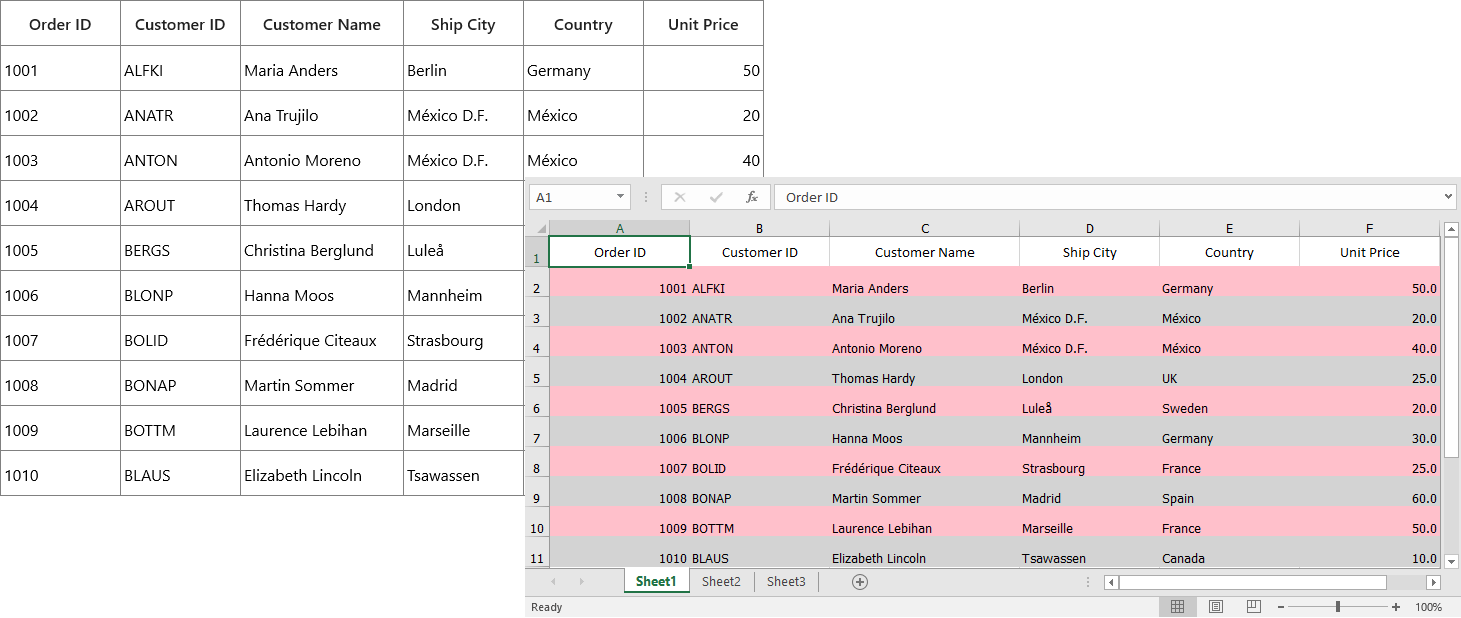Export To Excel in UWP DataGrid (SfDataGrid)
28 Feb 202524 minutes to read
SfDataGrid provides support to export data to excel. It also provides support for grouping, filtering, sorting, paging, unbound rows, merged cells, stacked headers and Details View while exporting.
The following assemblies needs to be added for exporting to excel.
- Syncfusion.SfGridConverter.UWP
- Syncfusion.XlsIO.UWP
For NuGet package, install Syncfusion.DataGridExcelExport.UWP package. For more details refer this UG link.
You can export SfDataGrid to excel by using the ExportToExcel extension method present in the Syncfusion.UI.Xaml.Grid.Converter namespace.
using Syncfusion.UI.Xaml.Grid.Converter;
var options = new ExcelExportingOptions();
options.ExcelVersion = ExcelVersion.Excel2013;
var excelEngine = dataGrid.ExportToExcel(dataGrid.View, options);
var workBook = excelEngine.Excel.Workbooks[0];
StorageFile storageFile = await KnownFolders.PicturesLibrary.CreateFileAsync("Sample" + ".xlsx", CreationCollisionOption.ReplaceExisting);
if (storageFile != null)
await workBook.SaveAsAsync(storageFile);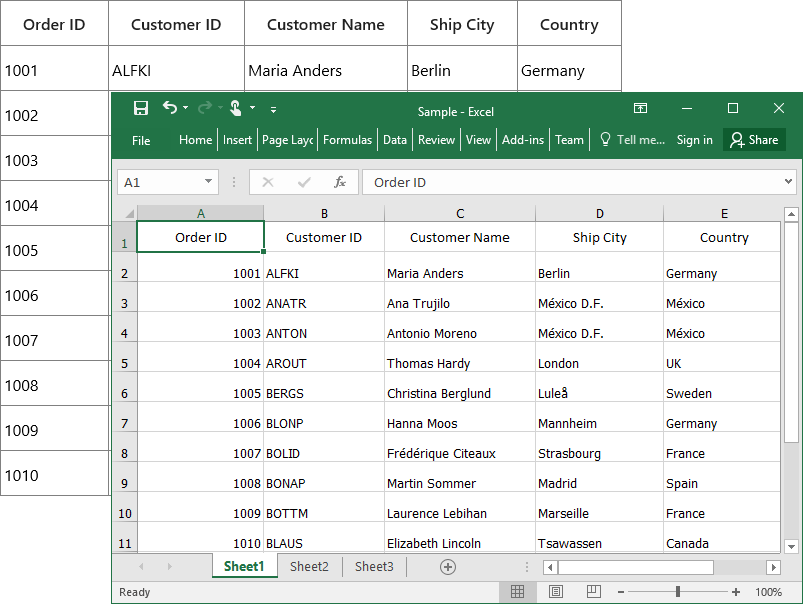
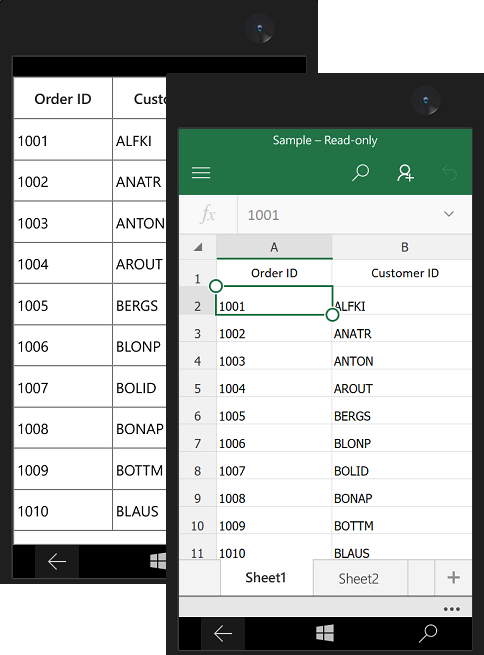
NOTE
SfDataGrid exports data to excel by using XlsIO.
Exporting options
Exporting operation can be customized by passing ExcelExportingOptions instance as argument to ExportToExcel method.
Export Mode
By default, actual value only will be exported to excel. If you want to export the display text, you need to set ExportMode property as Text.
var options = new ExcelExportingOptions();
options.ExcelVersion = ExcelVersion.Excel2013;
options.ExportMode = ExportMode.Text;
var excelEngine = dataGrid.ExportToExcel(dataGrid.View, options);
var workBook = excelEngine.Excel.Workbooks[0];
StorageFile storageFile = await KnownFolders.PicturesLibrary.CreateFileAsync("Sample" + ".xlsx", CreationCollisionOption.ReplaceExisting);
if (storageFile != null)
await workBook.SaveAsAsync(storageFile);ExportMode as Text

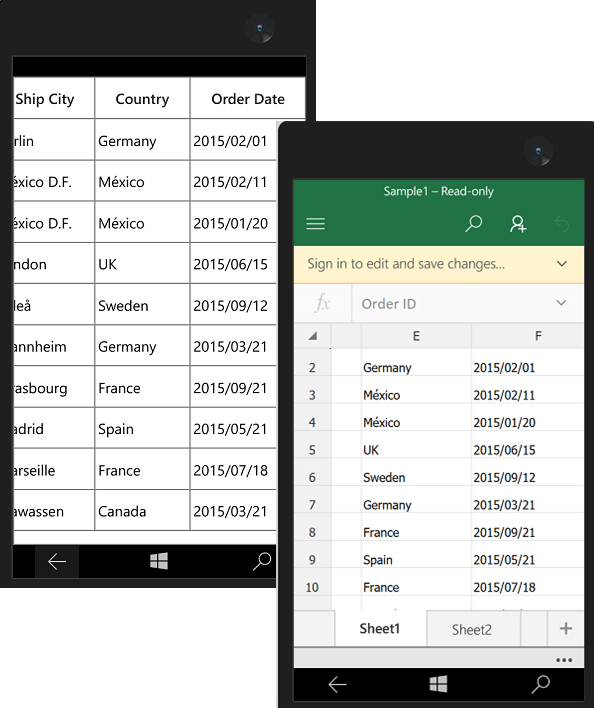
ExportMode as Value
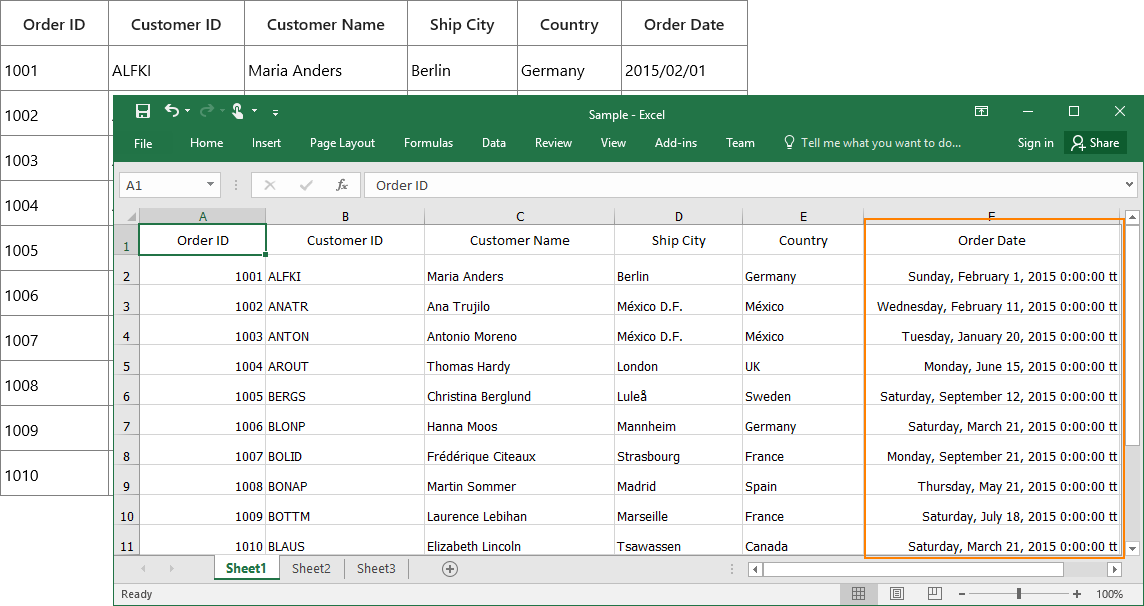
Export groups with outlines
By default, all the groups in DataGrid will be exported in expanded state. You can enable outlines in excel based on groups by setting the AllowOutlining property as true in ExcelExportingOptions.
var options = new ExcelExportingOptions();
options.ExcelVersion = ExcelVersion.Excel2013;
options.ExportMode = ExportMode.Value;
options.AllowOutlining = true;
var excelEngine = dataGrid.ExportToExcel(dataGrid.View, options);
var workBook = excelEngine.Excel.Workbooks[0];
StorageFile storageFile = await KnownFolders.PicturesLibrary.CreateFileAsync("Sample" + ".xlsx", CreationCollisionOption.ReplaceExisting);
if (storageFile != null)
await workBook.SaveAsAsync(storageFile);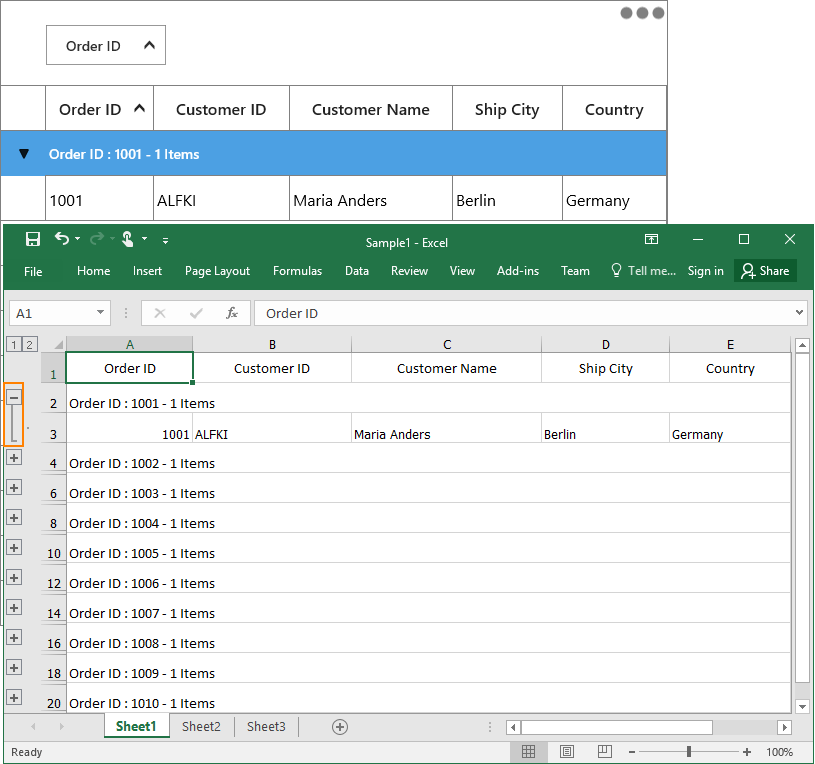
Exclude columns while exporting
By default, all the columns (including hidden columns) in SfDataGrid will be exported to Excel. If you want to exclude some columns while exporting to Excel, you can use ExcludeColumns field in ExcelExportingOptions.
var options = new ExcelExportingOptions();
options.ExcelVersion = ExcelVersion.Excel2013;
options.ExcludeColumns.Add("CustomerName");
options.ExcludeColumns.Add("Country");
var excelEngine = dataGrid.ExportToExcel(dataGrid.View, options);
var workBook = excelEngine.Excel.Workbooks[0];
StorageFile storageFile = await KnownFolders.PicturesLibrary.CreateFileAsync("Sample" + ".xlsx", CreationCollisionOption.ReplaceExisting);
if (storageFile != null)
await workBook.SaveAsAsync(storageFile);Here, the columns having CustomerName and Country as MappingName are excluded while exporting.
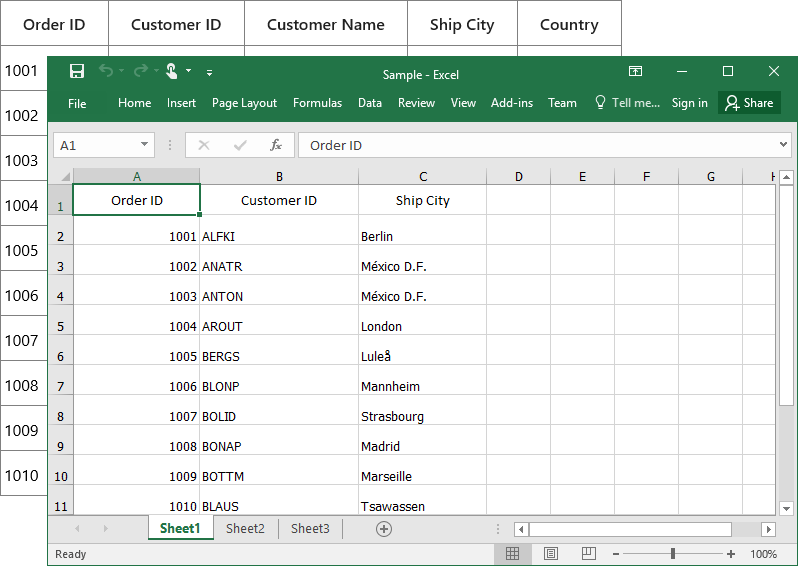
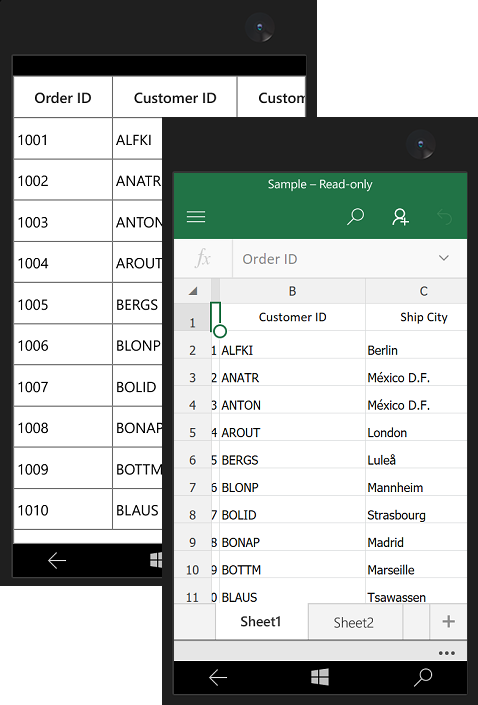
Excel Version
While exporting to Excel, you can specify the excel version by using ExcelVersion property.
var options = new ExcelExportingOptions();
options.ExcelVersion = ExcelVersion.Excel2013;
var excelEngine = dataGrid.ExportToExcel(dataGrid.View, options);
var workBook = excelEngine.Excel.Workbooks[0];
StorageFile storageFile = await KnownFolders.PicturesLibrary.CreateFileAsync("Sample" + ".xlsx", CreationCollisionOption.ReplaceExisting);
if (storageFile != null)
await workBook.SaveAsAsync(storageFile);Exporting stacked headers
You can export stacked headers to excel by setting ExportStackedHeaders property to true.
var options = new ExcelExportingOptions();
options.ExcelVersion = ExcelVersion.Excel2013;
options.ExportStackedHeaders = true;
var excelEngine = dataGrid.ExportToExcel(dataGrid.View, options);
var workBook = excelEngine.Excel.Workbooks[0];
StorageFile storageFile = await KnownFolders.PicturesLibrary.CreateFileAsync("Sample" + ".xlsx", CreationCollisionOption.ReplaceExisting);
if (storageFile != null)
await workBook.SaveAsAsync(storageFile);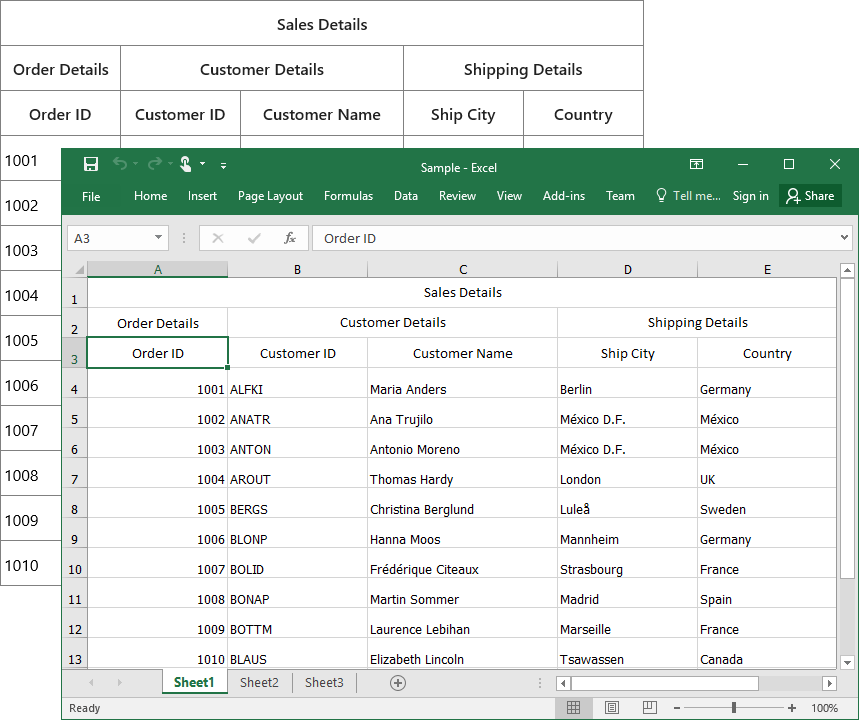

Exporting merged cells
You can export merged cells to excel by setting ExportMergedCells property as true.
var options = new ExcelExportingOptions();
options.ExcelVersion = ExcelVersion.Excel2013;
options.ExportMergedCells = true;
var excelEngine = dataGrid.ExportToExcel(dataGrid.View, options);
var workBook = excelEngine.Excel.Workbooks[0];
StorageFile storageFile = await KnownFolders.PicturesLibrary.CreateFileAsync("Sample" + ".xlsx", CreationCollisionOption.ReplaceExisting);
if (storageFile != null)
await workBook.SaveAsAsync(storageFile);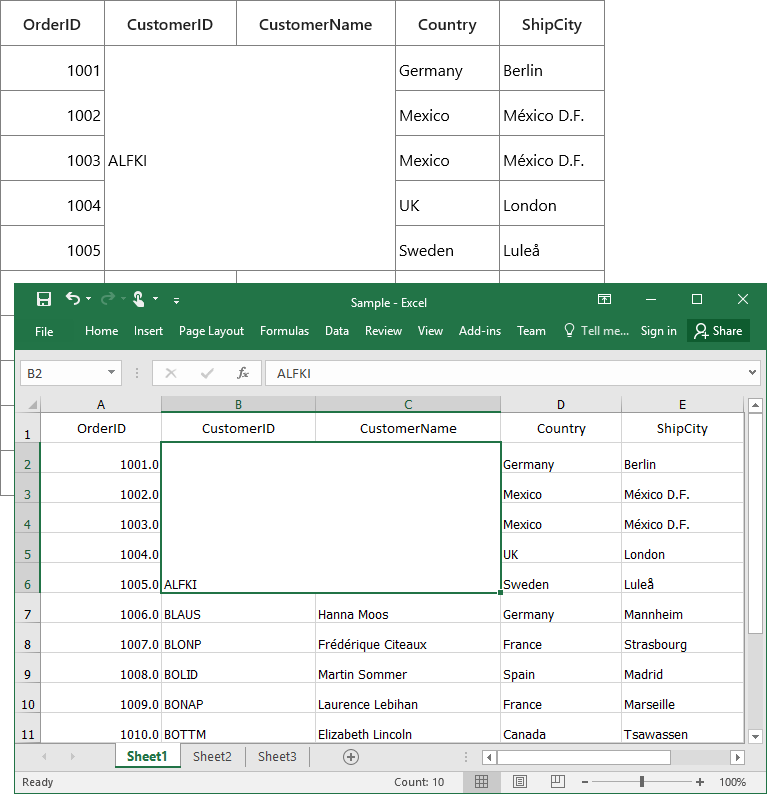
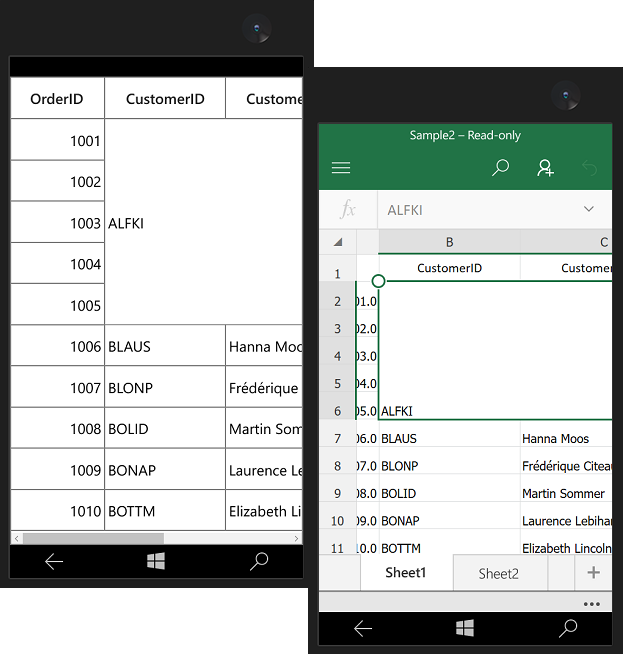
Exporting unbound rows
You can export unbound rows to excel by setting ExportUnBoundRows property as true.
var options = new ExcelExportingOptions();
options.ExcelVersion = ExcelVersion.Excel2013;
options.ExportUnBoundRows = true;
var excelEngine = dataGrid.ExportToExcel(dataGrid.View, options);
var workBook = excelEngine.Excel.Workbooks[0];
StorageFile storageFile = await KnownFolders.PicturesLibrary.CreateFileAsync("Sample" + ".xlsx", CreationCollisionOption.ReplaceExisting);
if (storageFile != null)
await workBook.SaveAsAsync(storageFile);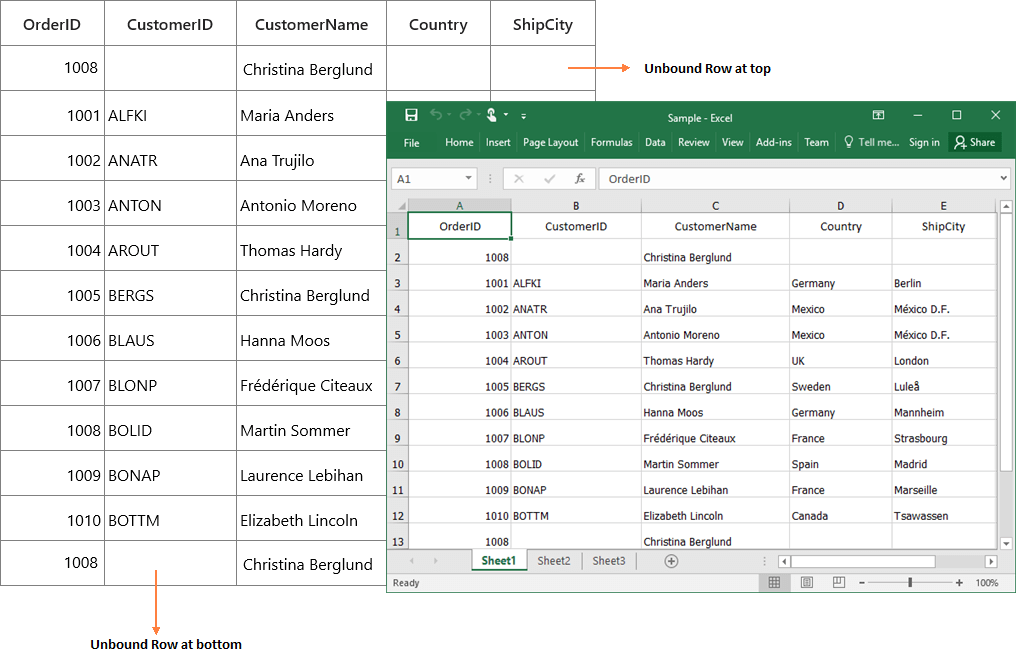
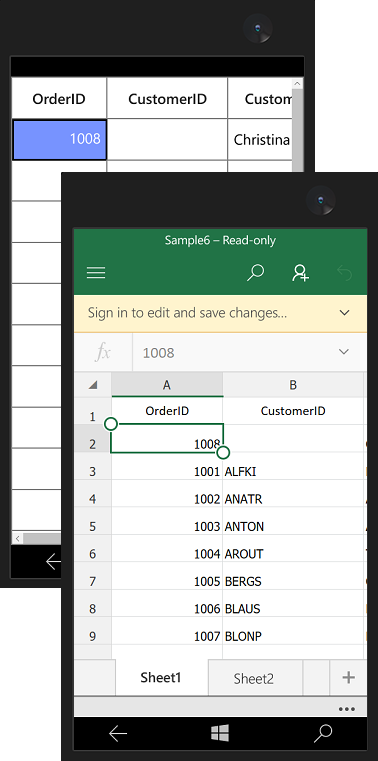
Changing start row and column index while exporting
You can export the data to specified row index and column index in worksheet, by setting StartRowIndex and StartColumnIndex properties.
var options = new ExcelExportingOptions();
options.ExcelVersion = ExcelVersion.Excel2013;
options.StartColumnIndex = 3;
options.StartRowIndex = 3;
var excelEngine = dataGrid.ExportToExcel(dataGrid.View, options);
var workBook = excelEngine.Excel.Workbooks[0];
StorageFile storageFile = await KnownFolders.PicturesLibrary.CreateFileAsync("Sample" + ".xlsx", CreationCollisionOption.ReplaceExisting);
if (storageFile != null)
await workBook.SaveAsAsync(storageFile);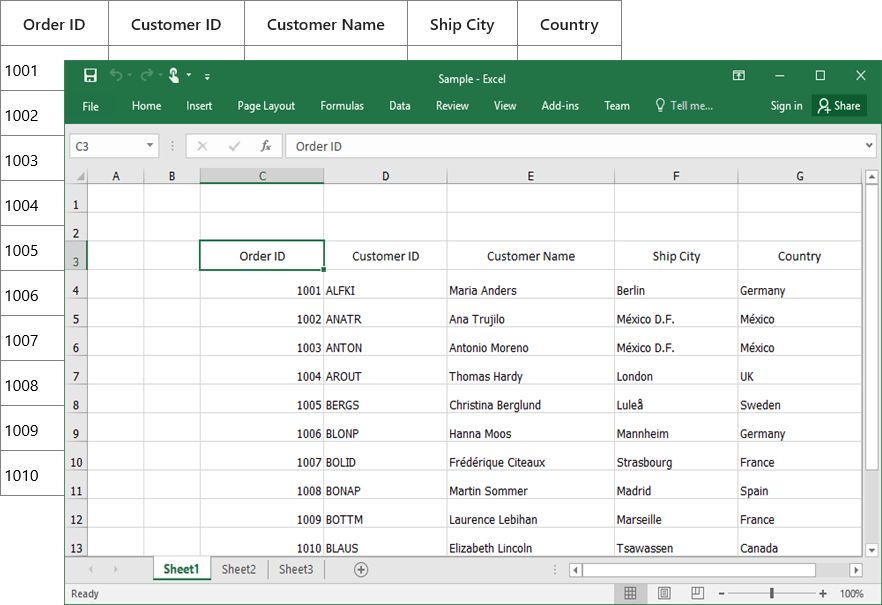

Saving options
Save as stream
After exporting to excel, you can save exported workbook to stream by using SaveAsAsync method.
var options = new ExcelExportingOptions();
options.ExcelVersion = ExcelVersion.Excel2013;
var excelEngine = dataGrid.ExportToExcel(dataGrid.View, options);
IWorkbook workBook = excelEngine.Excel.Workbooks[0];
FileStream stream=null;
string directory = @"Pictures\output5.xlsx";
await Task.Run(() =>
{
stream = new FileStream(directory, FileMode.Create);
});
await workBook.SaveAsAsync(stream);
workBook.Close();
excelEngine.Dispose();Save using FileSavePicker with MessageDialog
After exporting to excel, you can save exported workbook by opening MessageDialog.
var options = new ExcelExportingOptions();
options.ExcelVersion = ExcelVersion.Excel2013;
var excelEngine = dataGrid.ExportToExcel(dataGrid.View, options);
IWorkbook workBook = excelEngine.Excel.Workbooks[0];
var savePicker = new FileSavePicker
{
SuggestedStartLocation = PickerLocationId.Desktop,
SuggestedFileName = "Sample"
};
if (workBook.Version == ExcelVersion.Excel97to2003)
savePicker.FileTypeChoices.Add("Excel File (.xls)", new List<string>() { ".xls" });
else
savePicker.FileTypeChoices.Add("Excel File (.xlsx)", new List<string>() { ".xlsx" });
var storageFile = await savePicker.PickSaveFileAsync();
if (storageFile != null)
await workBook.SaveAsAsync(storageFile);
var messageDialog = new MessageDialog("Do you want to view the Document?", "File has been created successfully.");
var yesCmd = new UICommand("Yes");
var noCmd = new UICommand("No");
messageDialog.Commands.Add(yesCmd);
messageDialog.Commands.Add(noCmd);
var cmd = await messageDialog.ShowAsync();
if (cmd == yesCmd)
{
// Launch the saved file
bool success = await Windows.System.Launcher.LaunchFileAsync(storageFile);
}
workBook.Close();
excelEngine.Dispose();Opening the saved excel file
You can open the saved workbook using FileOpenPicker.
var excelEngine = dataGrid.ExportCollectionToExcel(this.dataGrid.View);
IWorkbook workBook = excelEngine.Excel.Workbooks[0];
StorageFile storageFile = await KnownFolders.PicturesLibrary.CreateFileAsync("Sample" + ".xlsx", CreationCollisionOption.ReplaceExisting);
if (storageFile != null)
await workBook.SaveAsAsync(storageFile);
FileOpenPicker openPicker = new FileOpenPicker();
openPicker.FileTypeFilter.Add(".xlsx");
openPicker.SuggestedStartLocation = PickerLocationId.PicturesLibrary;
StorageFile file = await openPicker.PickSingleFileAsync();
await Windows.System.Launcher.LaunchFileAsync(storageFile);Export Paging
While exporting data to excel, if paging is used, current page only will be exported, by default. If you want to export all pages, you need to set ExportAllPages property as True.
var options = new ExcelExportingOptions();
options.ExcelVersion = ExcelVersion.Excel2013;
options.ExportAllPages = true;
var excelEngine = dataGrid.ExportToExcel(dataGrid.View, options);
IWorkbook workBook = excelEngine.Excel.Workbooks[0];
StorageFile storageFile = await KnownFolders.PicturesLibrary.CreateFileAsync("Sample" + ".xlsx", CreationCollisionOption.ReplaceExisting);
if (storageFile != null)
await workBook.SaveAsAsync(storageFile);By default, all data will be exported to single sheet. If you want to export each page to different sheets, you need to use ExportPageOptions property.
var options = new ExcelExportingOptions();
options.ExcelVersion = ExcelVersion.Excel2013;
options.ExportAllPages = true;
options.ExportPageOptions = ExportPageOptions.ExportToDifferentSheets;
var excelEngine = dataGrid.ExportToExcel(dataGrid.View, options);
IWorkbook workBook = excelEngine.Excel.Workbooks[0];
StorageFile storageFile = await KnownFolders.PicturesLibrary.CreateFileAsync("Sample" + ".xlsx", CreationCollisionOption.ReplaceExisting);
if (storageFile != null)
await workBook.SaveAsAsync(storageFile);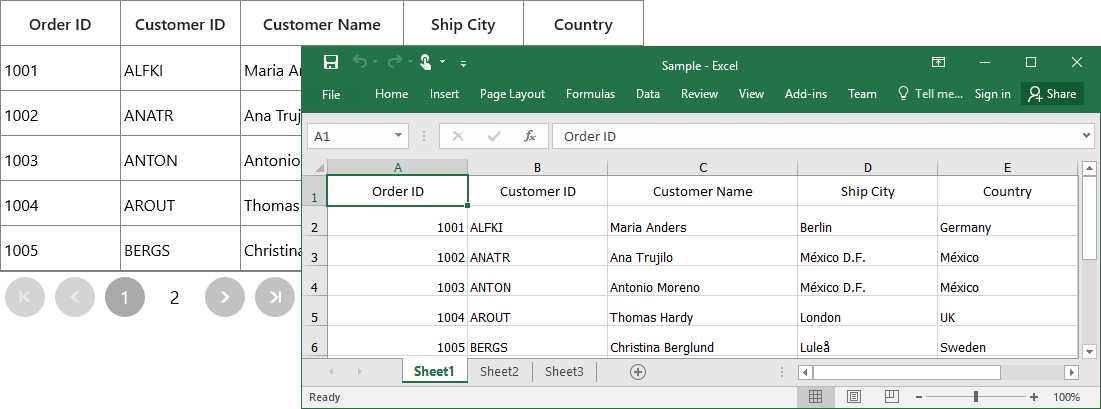
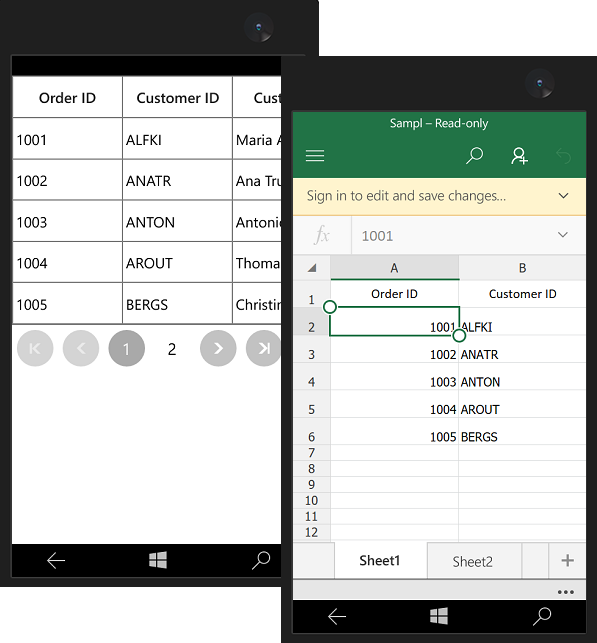
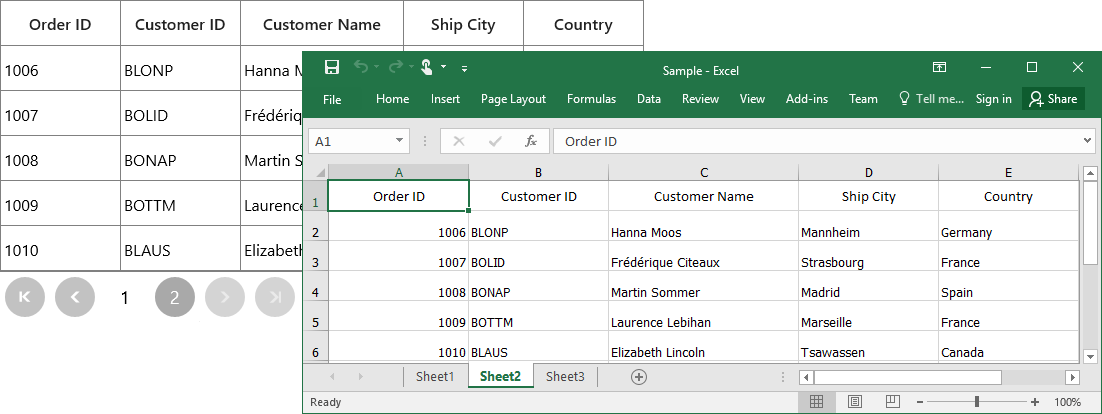

Export SelectedItems to Excel
By default, entire grid will be exported to Excel. You can export selected items only by passing SelectedItems to ExportToExcel method.
var options = new ExcelExportingOptions();
ExcelEngine excelEngine = new ExcelEngine();
IWorkbook workBook = excelEngine.Excel.Workbooks.Create();
workBook.Worksheets.Create();
dataGrid.ExportToExcel(dataGrid.SelectedItems, options, workBook.Worksheets[0]);
StorageFile storageFile = await KnownFolders.PicturesLibrary.CreateFileAsync("Sample" + ".xlsx", CreationCollisionOption.ReplaceExisting);
if (storageFile != null)
await workBook.SaveAsAsync(storageFile);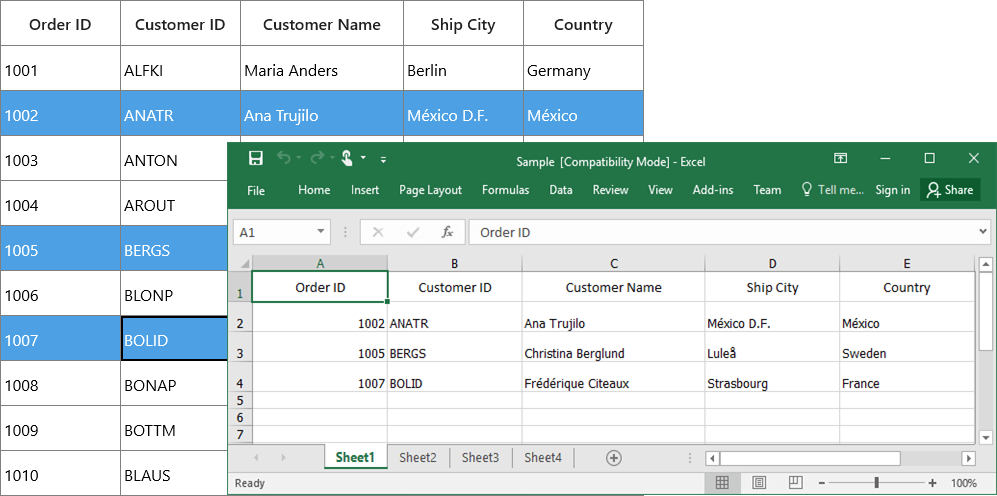
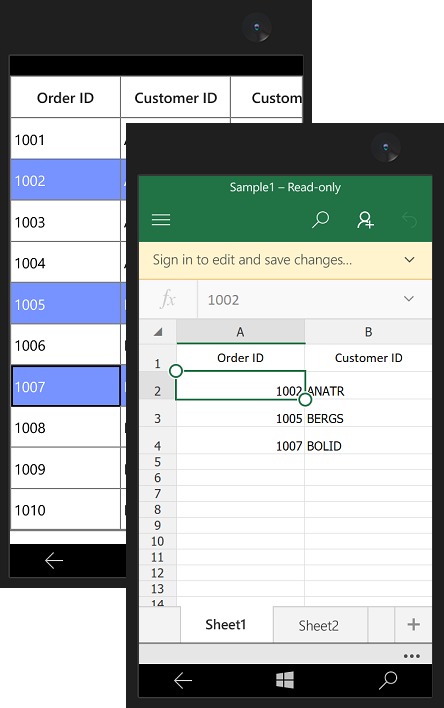
Export to XML
You can save exported workbook as Xml file also by using SaveAsXmlAsync method.
var options = new ExcelExportingOptions();
options.ExcelVersion = ExcelVersion.Excel2013;
var excelEngine = dataGrid.ExportToExcel(dataGrid.View, options);
IWorkbook workBook = excelEngine.Excel.Workbooks[0];
if (storageFile != null)
await workBook.SaveAsXmlAsync(storageFile,ExcelXmlSaveType.MSExcel);Export to CSV
You can save exported workbook as CSV by using SaveAsAsync method.
ExcelEngine excelEngine = null;
ExcelExportingOptions options = new ExcelExportingOptions();
options.ExcelVersion = ExcelVersion.Excel2013;
excelEngine = this.dataGrid.ExportToExcel(this.dataGrid.View, options);
var workBook = excelEngine.Excel.Workbooks[0];
var savePicker = new FileSavePicker
{
SuggestedStartLocation = PickerLocationId.Desktop,
SuggestedFileName = "Sample"
};
savePicker.FileTypeChoices.Add("Excel File (.csv)", new List<string>() { ".csv" });
var storageFile = await savePicker.PickSaveFileAsync();
await workBook.SaveAsAsync(storageFile, ",");
await Windows.System.Launcher.LaunchFileAsync(storageFile);
excelEngine.Dispose();Row Height and Column Width customization
After exporting data to excel, you can set different row height and column width for the columns based on your requirement.
var options = new ExcelExportingOptions();
options.ExcelVersion = ExcelVersion.Excel2013;
var excelEngine = dataGrid.ExportToExcel(dataGrid.View, options);
IWorkbook workBook = excelEngine.Excel.Workbooks[0];
workBook.Worksheets[0].SetRowHeight(2, 50);
workBook.Worksheets[0].SetColumnWidth(2, 50);
StorageFile storageFile = await KnownFolders.PicturesLibrary.CreateFileAsync("Sample" + ".xlsx", CreationCollisionOption.ReplaceExisting);
if (storageFile != null)
await workBook.SaveAsAsync(storageFile);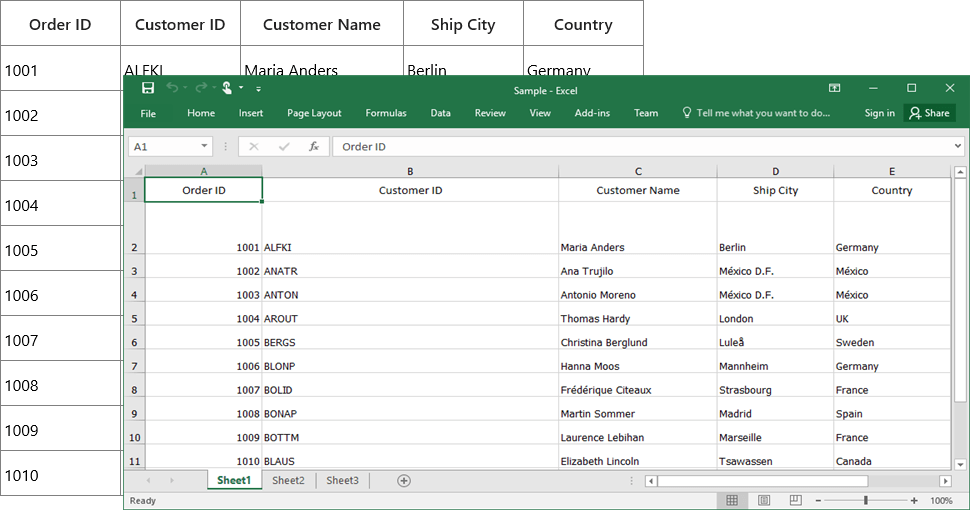
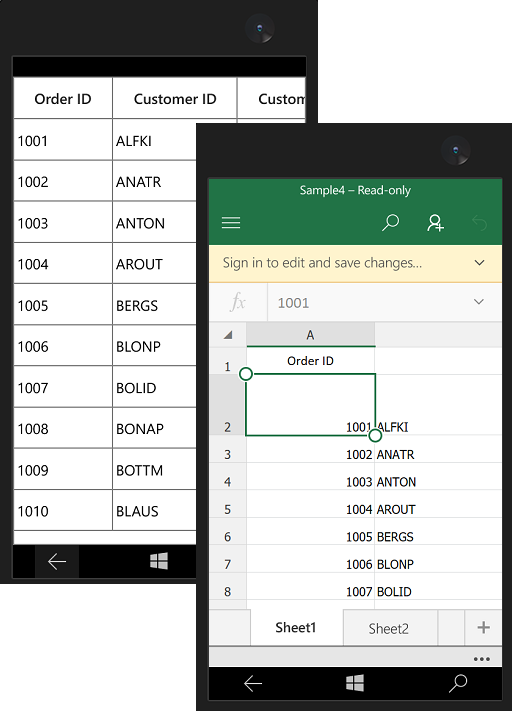
Styling cells based on CellType in Excel
You can customize the cell styles based on CellType by using ExportingEventHandler.
var options = new ExcelExportingOptions();
options.ExportingEventHandler = ExportingHandler;
options.AllowOutlining = true;
var excelEngine = dataGrid.ExportToExcel(dataGrid.View, options);
var workBook = excelEngine.Excel.Workbooks[0];
StorageFile storageFile = await KnownFolders.PicturesLibrary.CreateFileAsync("Sample" + ".xlsx", CreationCollisionOption.ReplaceExisting);
if (storageFile != null)
await workBook.SaveAsAsync(storageFile);
private static void ExportingHandler(object sender, GridExcelExportingEventArgs e)
{
if (e.CellType == ExportCellType.HeaderCell)
{
e.CellStyle.BackGroundBrush = new SolidColorBrush(Colors.LightPink);
e.CellStyle.ForeGroundBrush = new SolidColorBrush(Colors.White);
e.Handled = true;
}
else if (e.CellType == ExportCellType.RecordCell)
{
e.CellStyle.BackGroundBrush = new SolidColorBrush(Colors.LightSkyBlue);
e.Handled = true;
}
else if (e.CellType == ExportCellType.GroupCaptionCell)
{
e.CellStyle.BackGroundBrush = new SolidColorBrush(Colors.Wheat);
e.Handled = true;
}
}
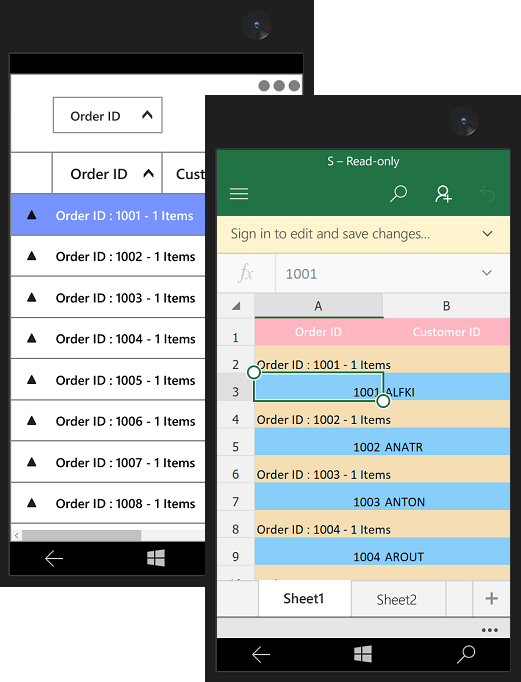
Cell customization in Excel while exporting
You can customize the cells by setting CellsExportingEventHandler in ExcelExportingOptions.
Customize cell value while exporting
You can customize the call values while exporting to excel by using CellsExportingEventHandler and ExcelExportingOptions.
var options = new ExcelExportingOptions();
options.ExcelVersion = ExcelVersion.Excel2013;
options.ExportingEventHandler = ExportingHandler;
var excelEngine = dataGrid.ExportToExcel(dataGrid.View, options);
IWorkbook workBook = excelEngine.Excel.Workbooks[0];
StorageFile storageFile = await KnownFolders.PicturesLibrary.CreateFileAsync("Sample" + ".xlsx", CreationCollisionOption.ReplaceExisting);
if (storageFile != null)
await workBook.SaveAsAsync(storageFile);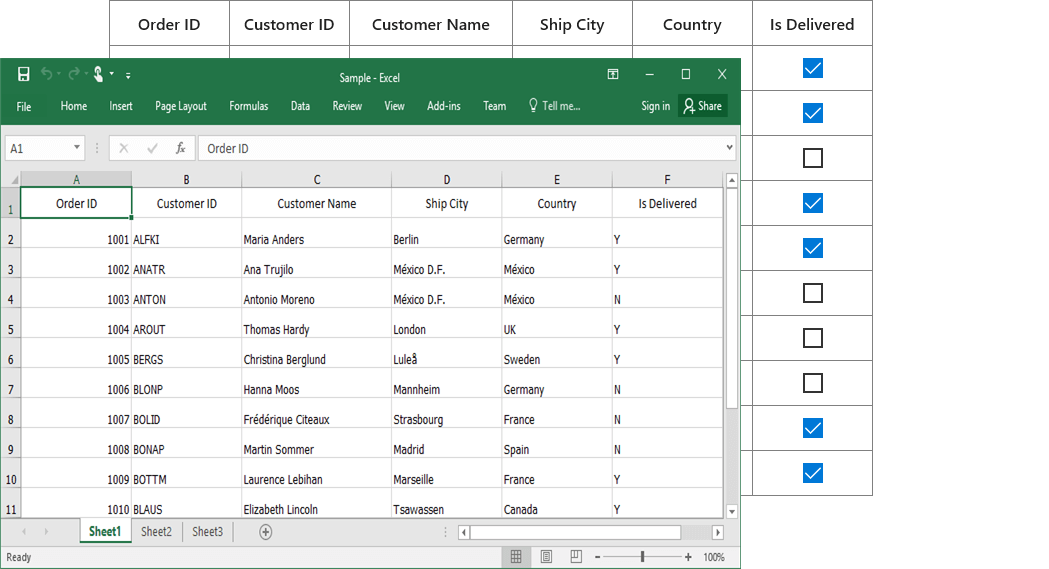

Here, cell values are changed for IsDelivered column based on custom condition.
Changing row style in excel based on data
You can customize the rows based on the record values by using CellsExportingEventHandler.
var options = new ExcelExportingOptions();
options.CellsExportingEventHandler = CellExportingHandler;
var excelEngine = dataGrid.ExportToExcel(dataGrid.View, options);
var workBook = excelEngine.Excel.Workbooks[0];
StorageFile storageFile = await KnownFolders.PicturesLibrary.CreateFileAsync("Sample" + ".xlsx", CreationCollisionOption.ReplaceExisting);
if (storageFile != null)
await workBook.SaveAsAsync(storageFile);
private static void CellExportingHandler(object sender, GridCellExcelExportingEventArgs e)
{
if (!(e.NodeEntry is RecordEntry))
return;
var record = e.NodeEntry as RecordEntry;
if ((record.Data as OrderInfo).Country == "Mexico")
{
e.Range.CellStyle.ColorIndex = ExcelKnownColors.Green;
e.Range.CellStyle.Font.Color = ExcelKnownColors.White;
}
}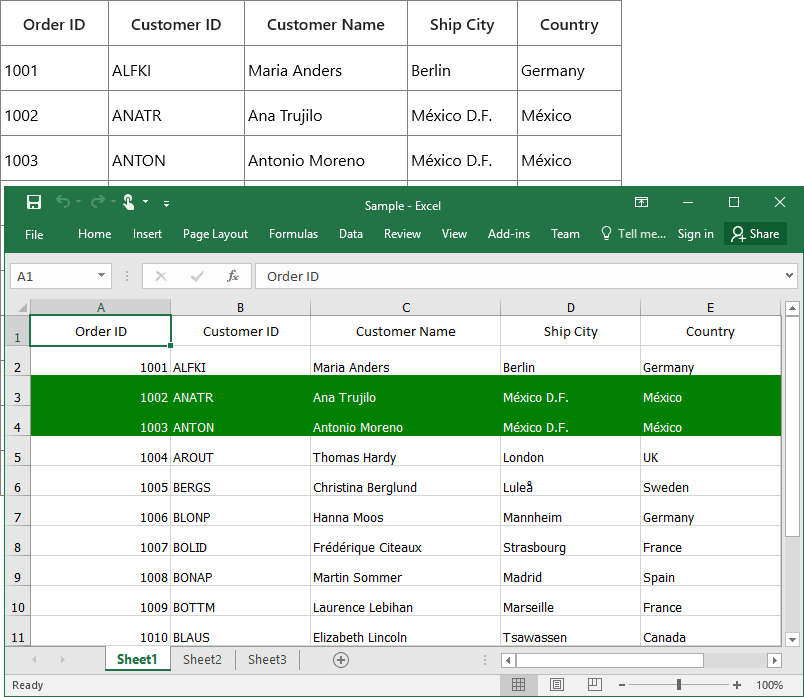
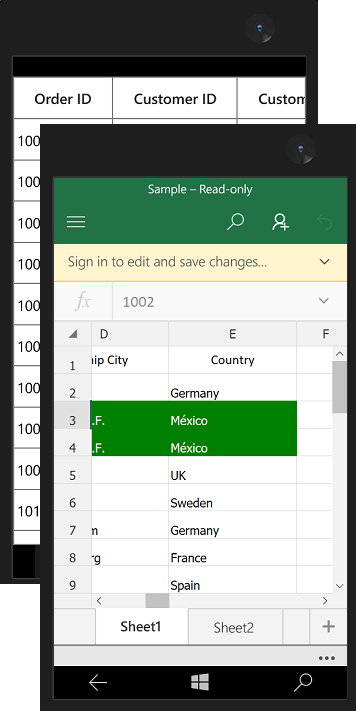
Here, records having the Country name as Mexico are customized.
Customize the cells based on Column Name
You can customize the cells based on GridCellExcelExportingEventArgs.ColumnName property in the CellsExportingEventHandler.
var options = new ExcelExportingOptions();
options.CellsExportingEventHandler = CellExportingHandler;
var excelEngine = dataGrid.ExportToExcel(dataGrid.View, options);
var workBook = excelEngine.Excel.Workbooks[0];
StorageFile storageFile = await KnownFolders.PicturesLibrary.CreateFileAsync("Sample" + ".xlsx", CreationCollisionOption.ReplaceExisting);
if (storageFile != null)
await workBook.SaveAsAsync(storageFile);
private static void CellExportingHandler(object sender, GridCellExcelExportingEventArgs e)
{
if (e.ColumnName != "OrderID")
return;
e.Range.CellStyle.Font.Size = 12;
e.Range.CellStyle.Font.Color = ExcelKnownColors.Pink;
e.Range.CellStyle.Font.FontName = "Segoe UI";
}Here, OrderID column cells are customized while exporting.
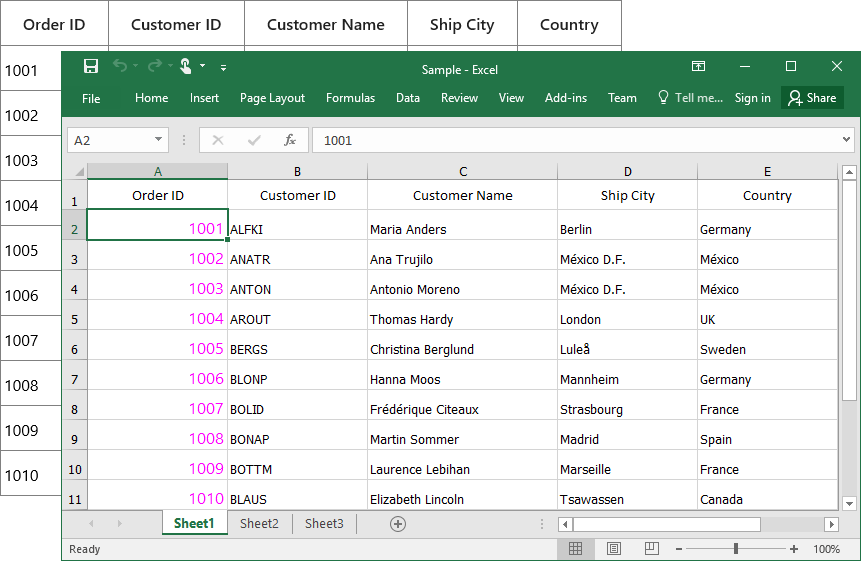

Customize exported workbook and worksheet
SfDataGrid exports to excel by using XlsIO.
Workbook
SfDataGrid provides option to return ExcelEngine from that you can get exported workbook. This allows you to protect, encrypt and add worksheet before saving.
var options = new ExcelExportingOptions();
options.ExcelVersion = ExcelVersion.Excel2013;
options.CellsExportingEventHandler = ExportingHandler;
var excelEngine = dataGrid.ExportToExcel(dataGrid.View, options);
var workBook = excelEngine.Excel.Workbooks[0];
StorageFile storageFile = await KnownFolders.PicturesLibrary.CreateFileAsync("Sample" + ".xlsx", CreationCollisionOption.ReplaceExisting);
if (storageFile != null)
await workBook.SaveAsAsync(storageFile);Worksheet customization
SfDataGrid provides support to export to already existing file or worksheet.
In the below code snippet, worksheet is created and passed to ExportToExcel method. In the same way, you can open already existing excel also using XlsIO.
var options = new ExcelExportingOptions();
ExcelEngine excelEngine = new ExcelEngine();
IWorkbook workBook = excelEngine.Excel.Workbooks.Create();
dataGrid.ExportToExcel(dataGrid.View, options, workBook.Worksheets[0]);
workBook.Version = ExcelVersion.Excel2013;Before saving workbook, you need to set the specific excel version by using IWorkbook.Version property. Here, you can directly manipulate the data in the worksheet.
Setting borders
You can set borders to excel cells by directly accessing worksheet after exporting data.
var options = new ExcelExportingOptions();
options.ExcelVersion = ExcelVersion.Excel2013;
var excelEngine = dataGrid.ExportToExcel(dataGrid.View, options);
var workBook = excelEngine.Excel.Workbooks[0];
workBook.Worksheets[0].UsedRange.BorderInside(ExcelLineStyle.Dash_dot, ExcelKnownColors.Black);
workBook.Worksheets[0].UsedRange.BorderAround(ExcelLineStyle.Dash_dot, ExcelKnownColors.Black);
StorageFile storageFile = await KnownFolders.PicturesLibrary.CreateFileAsync("Sample" + ".xlsx", CreationCollisionOption.ReplaceExisting);
if (storageFile != null)
await workBook.SaveAsAsync(storageFile);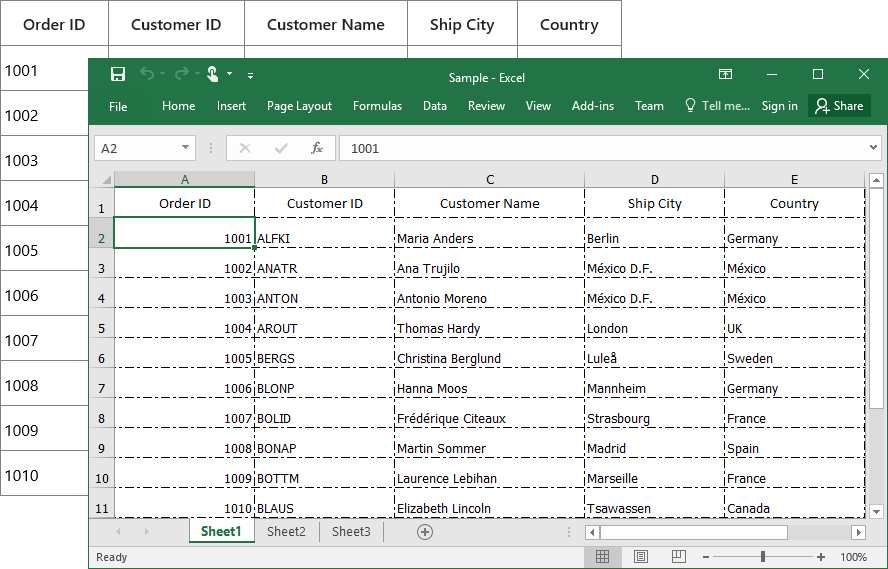
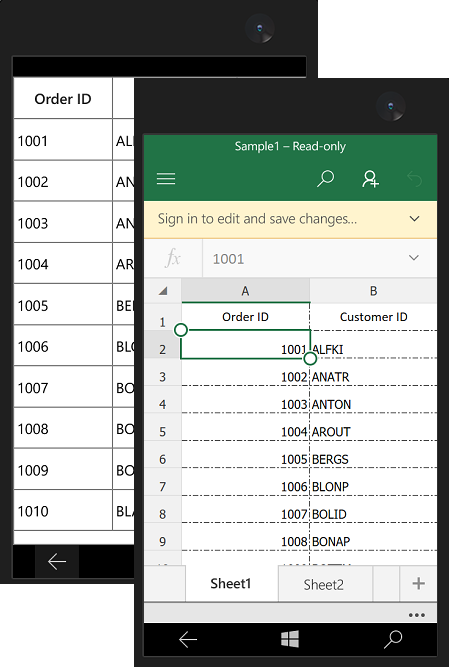
Enabling Filters
You can show filters in exported worksheet by enabling filter for the exported range in the worksheet.
var options = new ExcelExportingOptions();
options.ExcelVersion = ExcelVersion.Excel2013;
var excelEngine = dataGrid.ExportToExcel(dataGrid.View, options);
var workBook = excelEngine.Excel.Workbooks[0];
workBook.Worksheets[0].AutoFilters.FilterRange = workBook.Worksheets[0].UsedRange;
StorageFile storageFile = await KnownFolders.PicturesLibrary.CreateFileAsync("Sample" + ".xlsx", CreationCollisionOption.ReplaceExisting);
if (storageFile != null)
await workBook.SaveAsAsync(storageFile);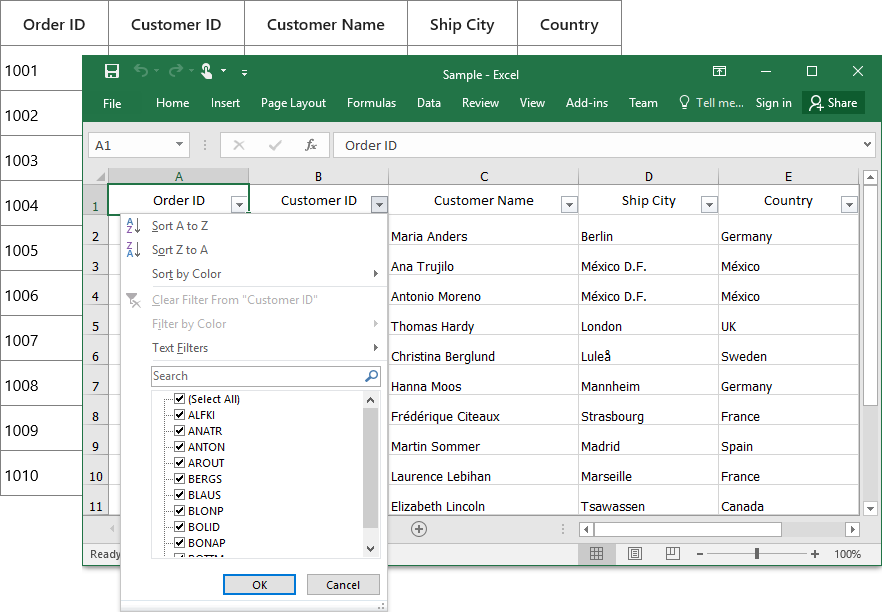
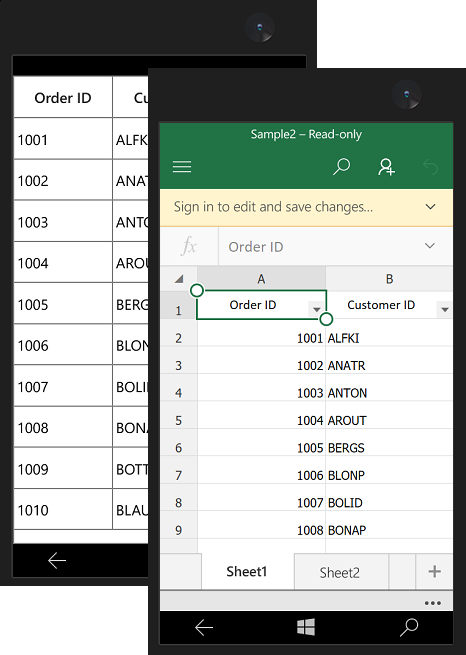
While using stacked headers, you can specify the range based on Stacked headers count.
var options = new ExcelExportingOptions();
options.ExcelVersion = ExcelVersion.Excel2013;
options.ExportStackedHeaders = true;
var excelEngine = dataGrid.ExportToExcel(dataGrid.View, options);
var workBook = excelEngine.Excel.Workbooks[0];
var range = "A" + (dataGrid.StackedHeaderRows.Count + 1).ToString() + ":" + workBook.Worksheets[0].UsedRange.End.AddressLocal;
excelEngine.Excel.Workbooks[0].Worksheets[0].AutoFilters.FilterRange = workBook.Worksheets[0].Range[range];
StorageFile storageFile = await KnownFolders.PicturesLibrary.CreateFileAsync("Sample" + ".xlsx", CreationCollisionOption.ReplaceExisting);
if (storageFile != null)
await workBook.SaveAsAsync(storageFile);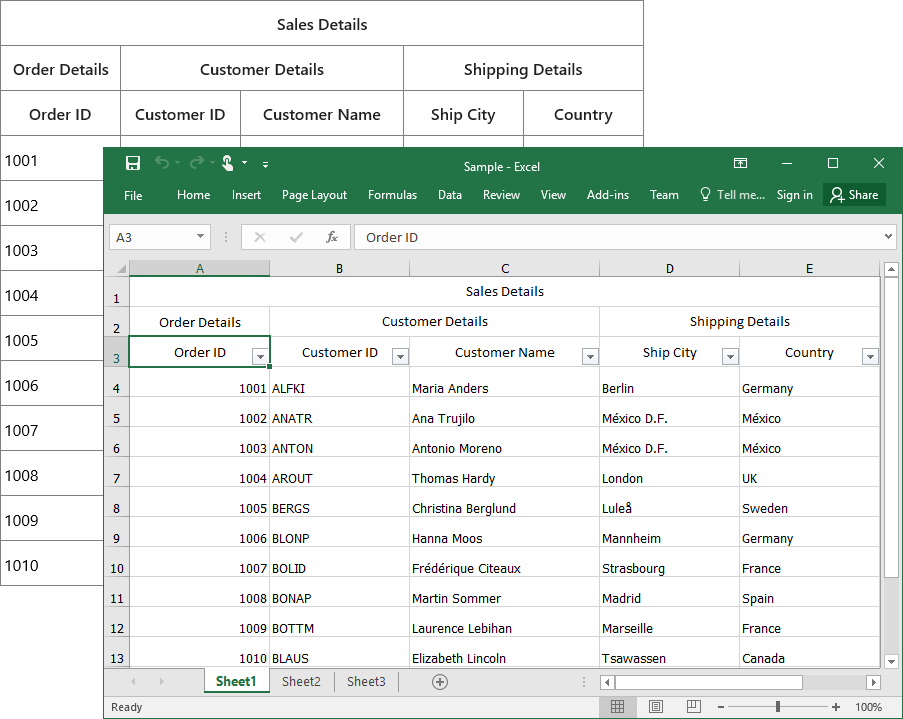
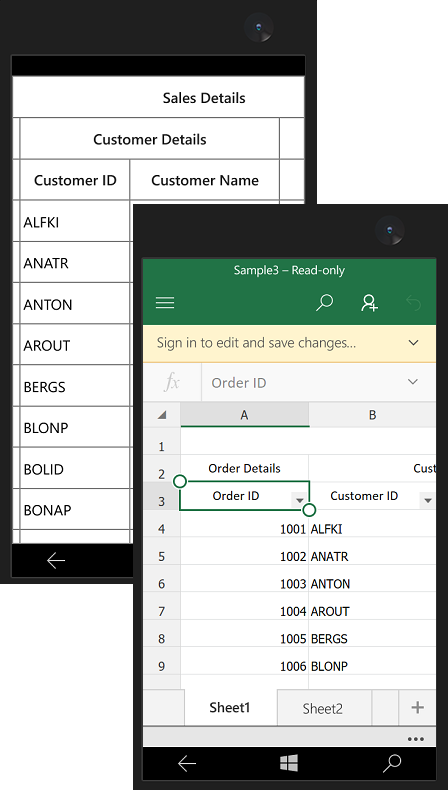
Customize the range of cells
You can customize the range of cells after exporting to excel by directly manipulating worksheet.
var options = new ExcelExportingOptions();
options.ExcelVersion = ExcelVersion.Excel2013;
var excelEngine = dataGrid.ExportToExcel(dataGrid.View, options);
var workBook = excelEngine.Excel.Workbooks[0];
workBook.Worksheets[0].Range["A2:A6"].CellStyle.Color = System.Drawing.Color.LightSlateGray;
workBook.Worksheets[0].Range["A2:A6"].CellStyle.Font.Color = ExcelKnownColors.White;
StorageFile storageFile = await KnownFolders.PicturesLibrary.CreateFileAsync("Sample" + ".xlsx", CreationCollisionOption.ReplaceExisting);
if (storageFile != null)
await workBook.SaveAsAsync(storageFile);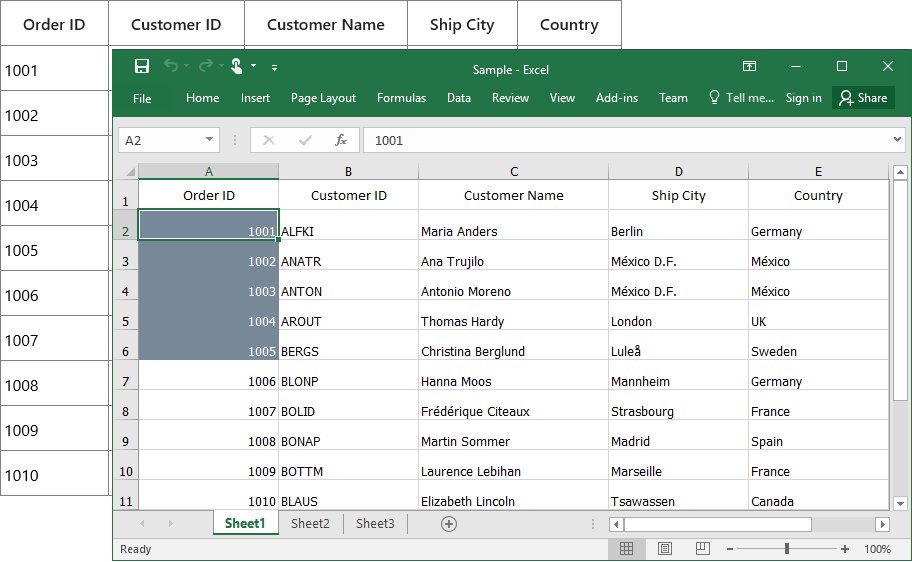
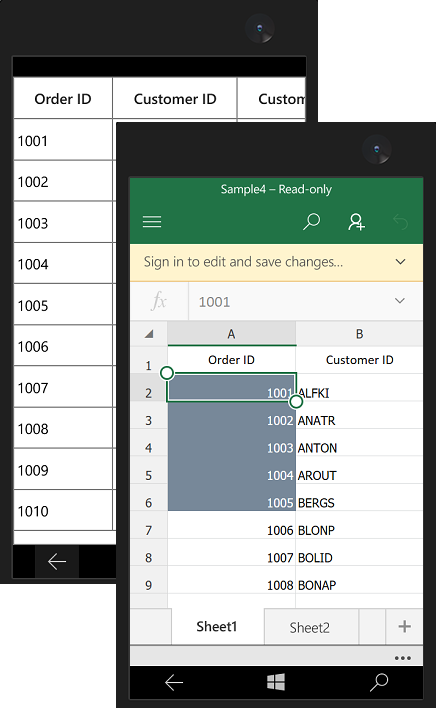
Exporting DetailsView
By default, DetailsViewDataGrid will be exported to Excel. You can customize its exporting operation by using ChildExportingEventHandler.
Excluding DetailsViewDataGrid while exporting
You can exclude particular DetailsViewDataGrid while exporting, by using the ChildExportingEventHandler and GridChildExportingEventArgs.Cancel.
var options = new ExcelExportingOptions();
options.ChildExportingEventHandler = ChildExportingHandler;
var excelEngine = dataGrid.ExportToExcel(dataGrid.View, options);
var workBook = excelEngine.Excel.Workbooks[0];
StorageFile storageFile = await KnownFolders.PicturesLibrary.CreateFileAsync("Sample" + ".xlsx", CreationCollisionOption.ReplaceExisting);
if (storageFile != null)
await workBook.SaveAsAsync(storageFile);
private static void ChildExportingHandler(object sender, GridChildExportingEventArgs e)
{
var recordEntry = e.NodeEntry as RecordEntry;
if ((recordEntry.Data as OrderInfo).OrderID == 1002)
e.Cancel = true;
}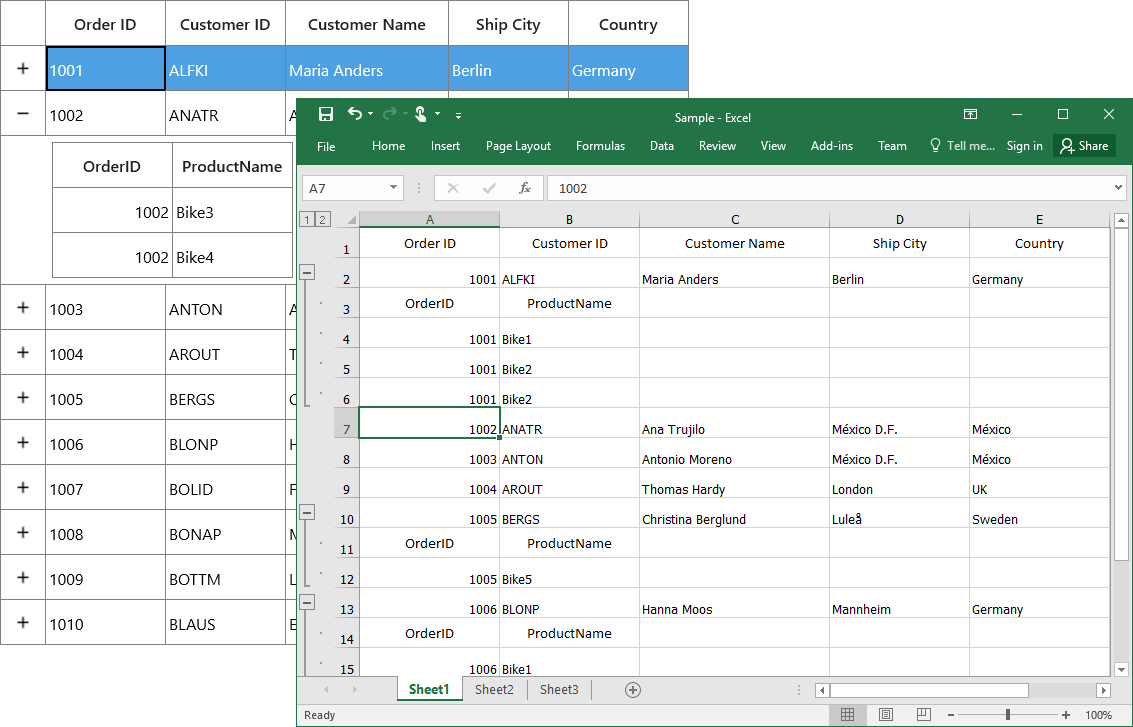
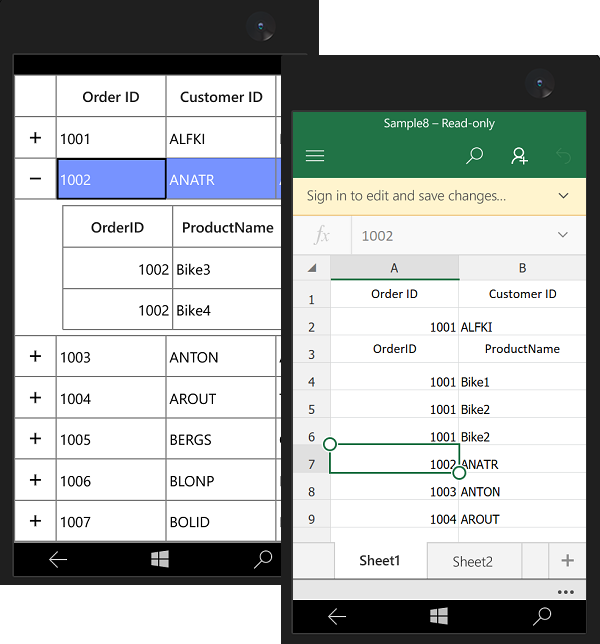
Here, DetailsViewDataGrid is not exported for the parent record having OrderID as 1002.
Excluding DetailsViewDataGrid columns from exporting
You can exclude DetailsViewDataGrid columns while exporting, by using ChildExportingEventHandler and GridChildExportingEventArgs.ExcludeColumns.
var options = new ExcelExportingOptions();
options.ExcelVersion = ExcelVersion.Excel2013;
options.ChildExportingEventHandler = ChildExportingHandler;
var excelEngine = dataGrid.ExportToExcel(dataGrid.View, options);
var workBook = excelEngine.Excel.Workbooks[0];
StorageFile storageFile = await KnownFolders.PicturesLibrary.CreateFileAsync("Sample" + ".xlsx", CreationCollisionOption.ReplaceExisting);
if (storageFile != null)
await workBook.SaveAsAsync(storageFile);
private static void ChildExportingHandler(object sender, GridChildExportingEventArgs e)
{
e.ExcludeColumns.Add("OrderID");
}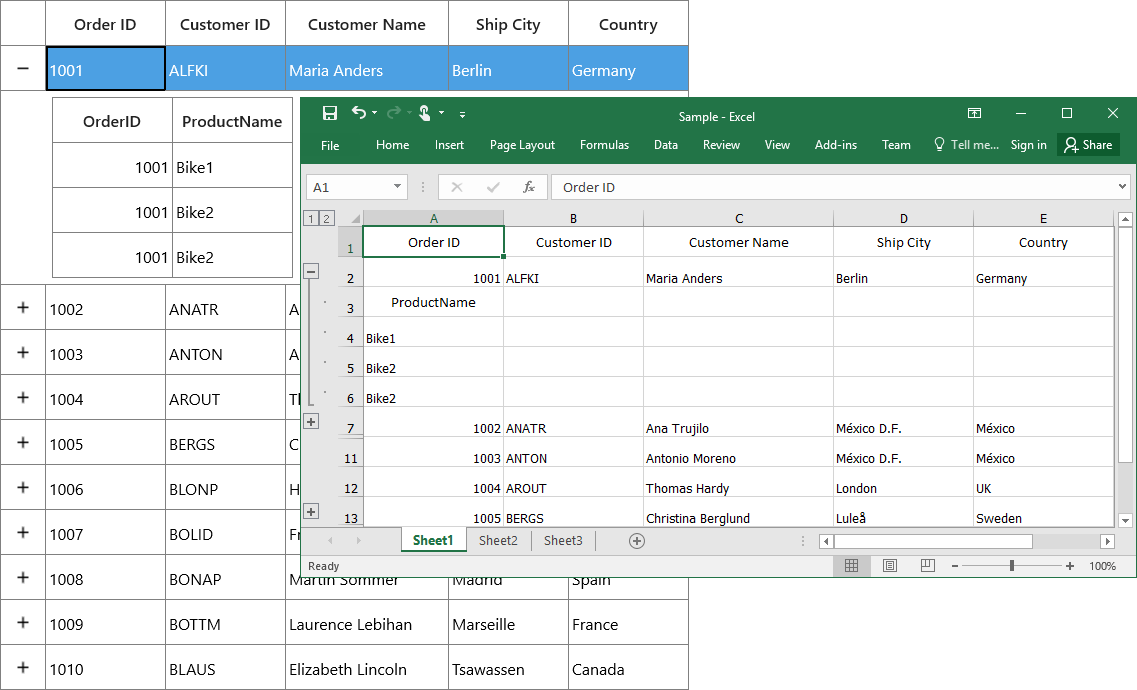
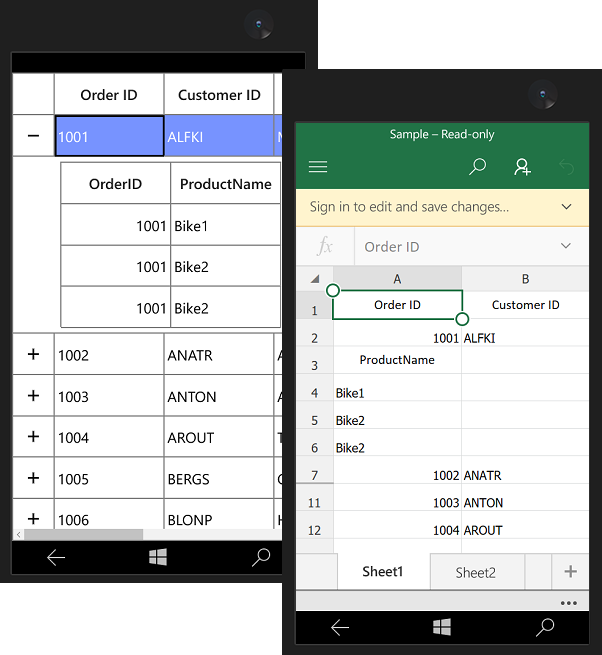
Here, OrderID column is displayed in DetailsViewDataGrid and it is excluded while exporting to excel.
Customizing DetailsViewDataGrid cells
Like parent DataGrid, you can customize the DetailsViewDataGrid cells also by using CellsExportingEventHandler. Based on GridCellExcelExportingEventArgs.GridViewDefinition property, you can identify the particular DetailsViewDataGrid and customize it.
var options = new ExcelExportingOptions();
options.ExcelVersion = ExcelVersion.Excel2013;
var options = new ExcelExportingOptions();
options.ExcelVersion = ExcelVersion.Excel2013;
options.CellsExportingEventHandler = ChildExportingHandler;
var excelEngine = dataGrid.ExportToExcel(dataGrid.View, options);
var workBook = excelEngine.Excel.Workbooks[0];
StorageFile storageFile = await KnownFolders.PicturesLibrary.CreateFileAsync("Sample" + ".xlsx", CreationCollisionOption.ReplaceExisting);
if (storageFile != null)
await workBook.SaveAsAsync(storageFile);
private static void ChildExportingHandler(object sender, GridCellExcelExportingEventArgs e)
{
if (e.GridViewDefinition == null || e.GridViewDefinition.RelationalColumn !="ProductDetails")
return;
if (e.ColumnName == "OrderID")
{
e.Range.CellStyle.Font.Size = 12;
e.Range.CellStyle.Font.Color = ExcelKnownColors.Blue;
e.Range.CellStyle.Font.FontName = "Segoe UI";
}
}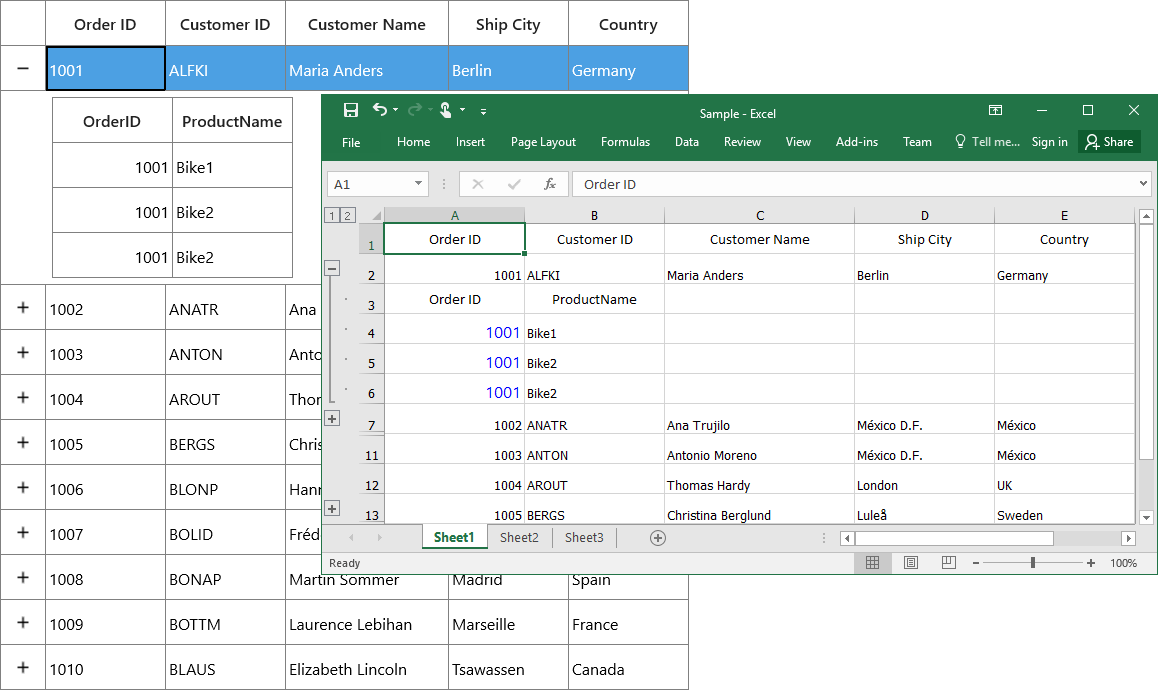
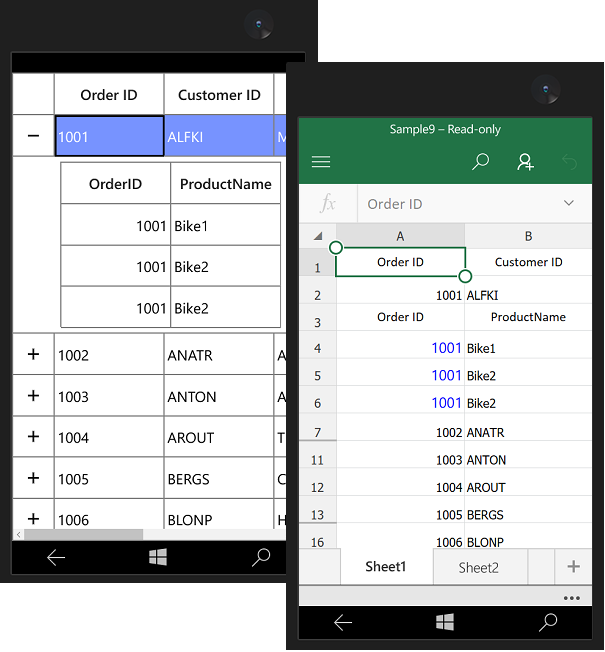
Performance
Using ExcelExportingOptions.CellsExportingEventHandler and changing settings for each cell will consume more memory and time consumption. So, avoid using CellsExportingEventHandler and instead of you can do the required settings in the exported sheet.
Formatting column without using CellsExportingEventHandler
You can perform cell level customization such as row-level styling, formatting particular column in the exported worksheet.
In the below code snippet, NumberFormat for Unit Price column is changed in the exported sheet after exporting without using CellsExportingEventHandler.
var options = new ExcelExportingOptions();
options.ExportMode = ExportMode.Value;
options.ExcelVersion = ExcelVersion.Excel2013;
var excelEngine = dataGrid.ExportToExcel(dataGrid.View, options);
IWorkbook workBook = excelEngine.Excel.Workbooks[0];
workBook.ActiveSheet.Columns[4].NumberFormat = "0.0";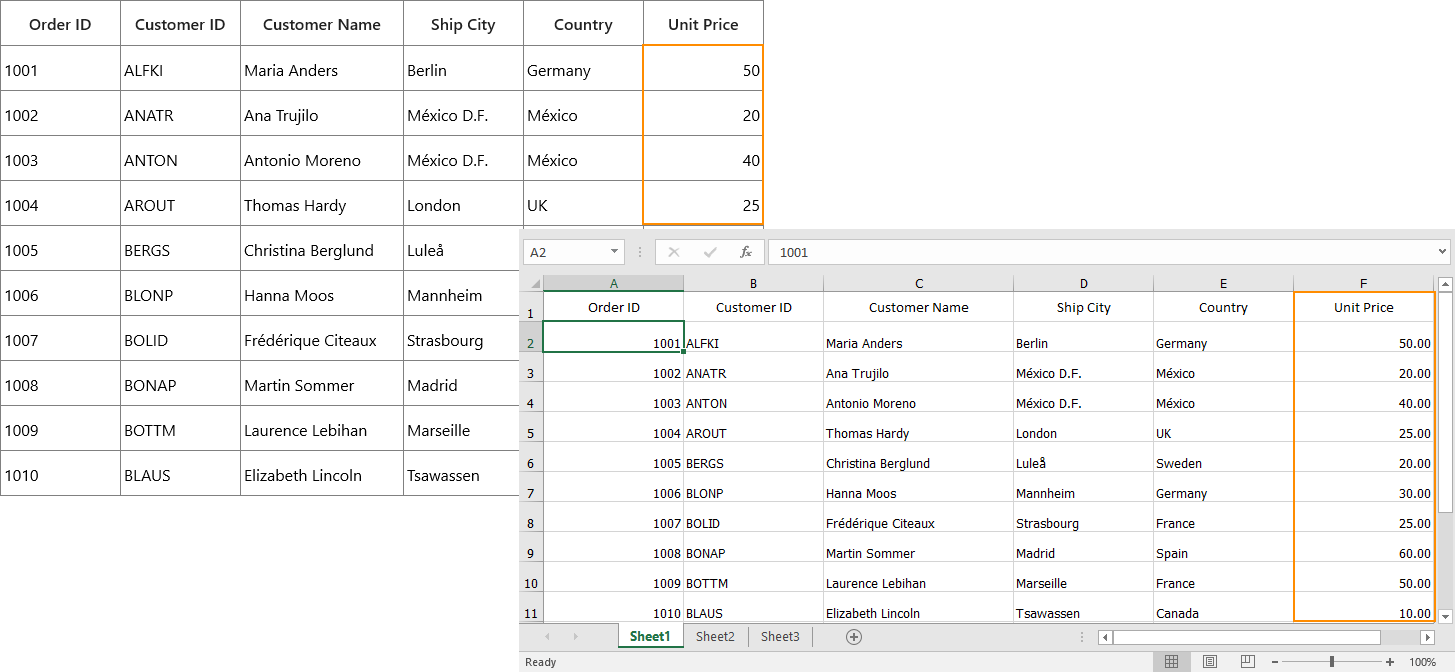
Alternate row styling without using CellsExportingEventHandler
In the below code snippet, the background color of rows in excel is changed based on row index using conditional formatting for better performance.
var options = new ExcelExportingOptions();
options.ExportMode = ExportMode.Value;
options.ExcelVersion = ExcelVersion.Excel2013;
var excelEngine = dataGrid.ExportToExcel(dataGrid.View, options);
IWorkbook workBook = excelEngine.Excel.Workbooks[0];
IConditionalFormats condition = workBook.ActiveSheet.Range[2,1,this.dataGrid.View.Records.Count+1,this.dataGrid.Columns.Count].ConditionalFormats;
IConditionalFormat condition1 = condition.AddCondition();
condition1.FormatType = ExcelCFType.Formula;
condition1.FirstFormula = "MOD(ROW(),2)=0";
condition1.BackColorRGB = System.Drawing.Color.Pink;
IConditionalFormat condition2 = condition.AddCondition();
condition2.FormatType = ExcelCFType.Formula;
condition2.FirstFormula = "MOD(ROW(),2)=1";
condition2.BackColorRGB = System.Drawing.Color.LightGray;